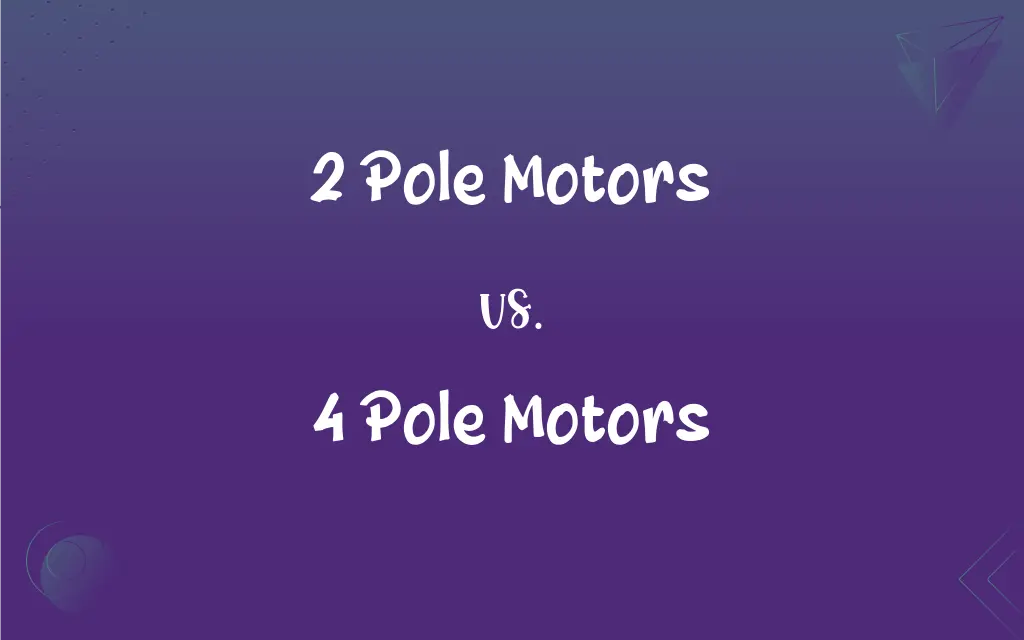2 Pole Motors vs. 4 Pole Motors: What's the Difference?
Edited by Janet White || By Harlon Moss || Updated on October 2, 2023
2 pole motors operate at higher speeds with less torque, while 4 pole motors deliver lower speeds with higher torque, both relating to electrical poles used.

Key Differences
The 2 pole motors, functioning with one pair of magnetic poles, inherently operate at higher rotational speeds, which generally implies less torque generation per unit of applied electrical energy. Conversely, 4 pole motors, featuring two pairs of magnetic poles, characteristically run at lower speeds but generate higher torque due to the increased electromagnetic interactions within the motor, providing divergent performance metrics suitable for various application domains.
While 2 pole motors naturally gravitate towards applications demanding lesser torque but elevated operational speeds, such as in fans or small electric tools, 4 pole motors incline towards scenarios requiring higher torque and moderated speeds, like conveyer belts or pumps, illustrating their applicative predispositions deriving from their intrinsic electrical and magnetic designs.
In 2 pole motors, the lesser amount of electromagnetic interactions results in a diminished demand for maintenance and, often, a compact design, while in 4 pole motors, the increased electromagnetic interactions may necessitate more frequent attention to maintain optimal performance, thus weaving their maintenance and design complexities into their operational narratives.
Operational efficiency and energy consumption in 2 pole motors often lean towards being advantageous in continuous, high-speed operations, whereas 4 pole motors might demonstrate superior operational efficiency in scenarios requiring steady, torque-intensive performances, embedding their energy profiles within their respective operational niches.
The selection between 2 pole motors and 4 pole motors often distills down to the specific requirements of the application in question: high-speed, lower-torque operations, or low-speed, high-torque tasks, providing engineers and designers with varied electromechanical options to aptly cater to diverse industrial and consumer applications.
ADVERTISEMENT
Comparison Chart
Operational Speed
Higher
Lower
Torque Generation
Lower
Higher
Typical Applications
High-speed, low-torque applications
Low-speed, high-torque applications
Maintenance and Design
Generally simpler and may require less maintenance
Can be more complex and may require more maintenance
Energy Consumption Patterns
Often advantageous in continuous, high-speed operations
May be more efficient in steady, high-torque tasks
ADVERTISEMENT
2 Pole Motors and 4 Pole Motors Definitions
2 Pole Motors
Motors with higher operational speeds.
2 pole motors are frequently utilized in household fans.
4 Pole Motors
Motors with lower operational speeds.
4 pole motors are chosen for many industrial machines for their stability.
2 Pole Motors
Motors that contain a single pair of magnetic poles.
2 pole motors exhibit fewer electromagnetic interactions.
4 Pole Motors
Apt for applications necessitating higher torque.
Conveyor systems frequently utilize 4 pole motors.
2 Pole Motors
Generally suitable for applications requiring lesser torque.
Small power tools often employ 2 pole motors.
4 Pole Motors
May demand more frequent maintenance and larger design.
Industrial pumps with 4 pole motors may require periodic service.
2 Pole Motors
Typically smaller and require lesser maintenance.
2 pole motors can be found in compact electrical devices.
4 Pole Motors
Efficient in steady, high-torque operations.
In hydraulic systems, 4 pole motors can offer reliable performance.
2 Pole Motors
Efficient for high-speed continuous operations.
In cooling applications, 2 pole motors are prevalent due to their rapid spin.
4 Pole Motors
Motors possessing two pairs of magnetic poles.
4 pole motors generate increased electromagnetic interactions.
FAQs
What is a 2 pole motor?
A 2 pole motor is an electric motor with two magnetic poles, one north and one south, in its stator.
How is the speed of a 2 pole motor characterized?
Generally, 2 pole motors have higher synchronous speeds, calculated by 120 x Frequency / Poles.
Are 2 pole motors efficient?
2 pole motors may offer high speeds and can be efficient but tend to have lower torque compared to 4 pole motors.
Where are 2 pole motors typically used?
They're often used in applications requiring high RPMs, like pumps or fans.
Can 2 pole motors be used in industrial applications?
Yes, especially in scenarios where high speed and lower torque are permissible.
Are 4 pole motors suitable for variable-speed applications?
Yes, and they're often chosen for variable-speed applications due to their torque characteristics at lower speeds.
Are 2 pole motors usually loud?
They can be noisier due to higher speeds, depending on the application and build.
Do 4 pole motors require regular maintenance?
Like all motors, maintenance (e.g., bearing lubrication and brush replacement) is vital for longevity.
What are the key characteristics of 2 pole motors?
High speed, usually lower torque, and often compact sizes.
Can 2 pole motors be single-phase or three-phase?
Yes, 2 pole motors can come in both single-phase and three-phase variations.
What are the energy efficiency considerations for 4 pole motors?
4 pole motors can be energy efficient, particularly in applications demanding higher torque at lower speeds.
How do 4 pole motors manage heat dissipation?
Their lower speeds may aid in managing heat dissipation effectively, contingent on build and application.
How is the durability of 2 pole motors?
Durability can be comparable to other motors, contingent on usage, maintenance, and build quality.
What is a 4 pole motor?
A 4 pole motor possesses four magnetic poles in its stator, comprising two north and two south poles.
In what applications are 4 pole motors commonly used?
These are widespread in industries where higher torque and lower speeds are required, like conveyors.
How does speed compare in 4 pole motors?
4 pole motors generally have lower RPMs than 2 pole motors, providing more torque.
Are 4 pole motors robust in construction?
They can be, and their robustness and torque make them suitable for many industrial applications.
Can 4 pole motors operate quietly?
Often, yes. Due to their lower speeds, they may operate with reduced noise in comparison to 2 pole motors.
Can 4 pole motors be used in residential applications?
Yes, especially in appliances where lower speed and higher torque are needed, like washing machines.
Can 2 pole motors be energy efficient?
Yes, they can be energy-efficient, especially in applications well-suited to their characteristics.
About Author
Written by
Harlon MossHarlon is a seasoned quality moderator and accomplished content writer for Difference Wiki. An alumnus of the prestigious University of California, he earned his degree in Computer Science. Leveraging his academic background, Harlon brings a meticulous and informed perspective to his work, ensuring content accuracy and excellence.
Edited by
Janet WhiteJanet White has been an esteemed writer and blogger for Difference Wiki. Holding a Master's degree in Science and Medical Journalism from the prestigious Boston University, she has consistently demonstrated her expertise and passion for her field. When she's not immersed in her work, Janet relishes her time exercising, delving into a good book, and cherishing moments with friends and family.































































